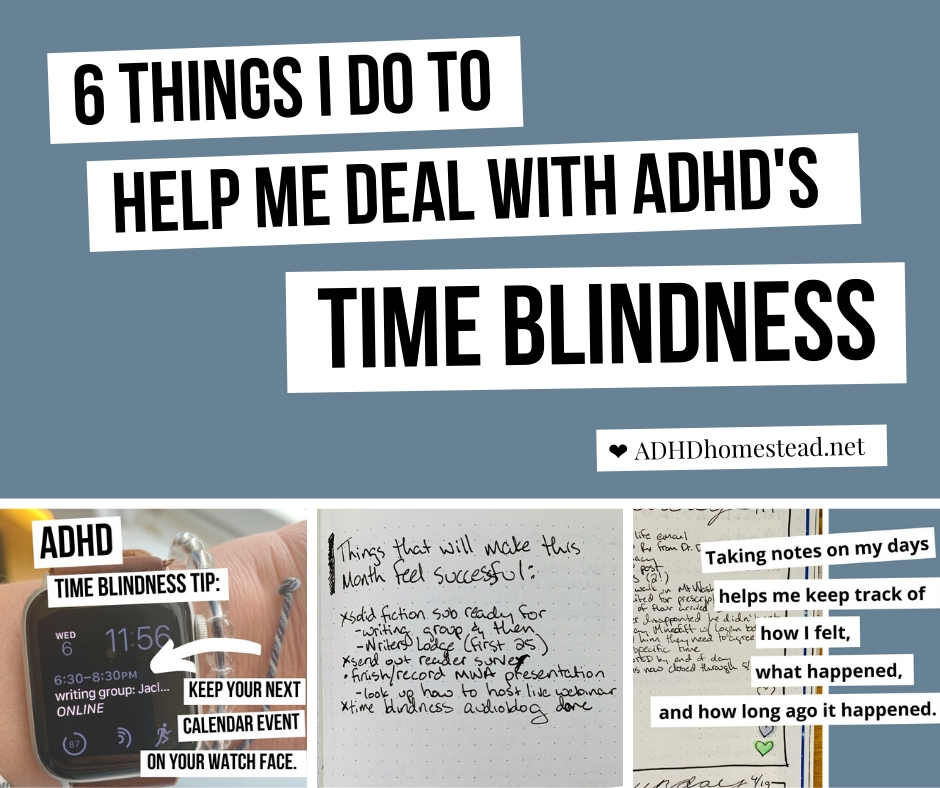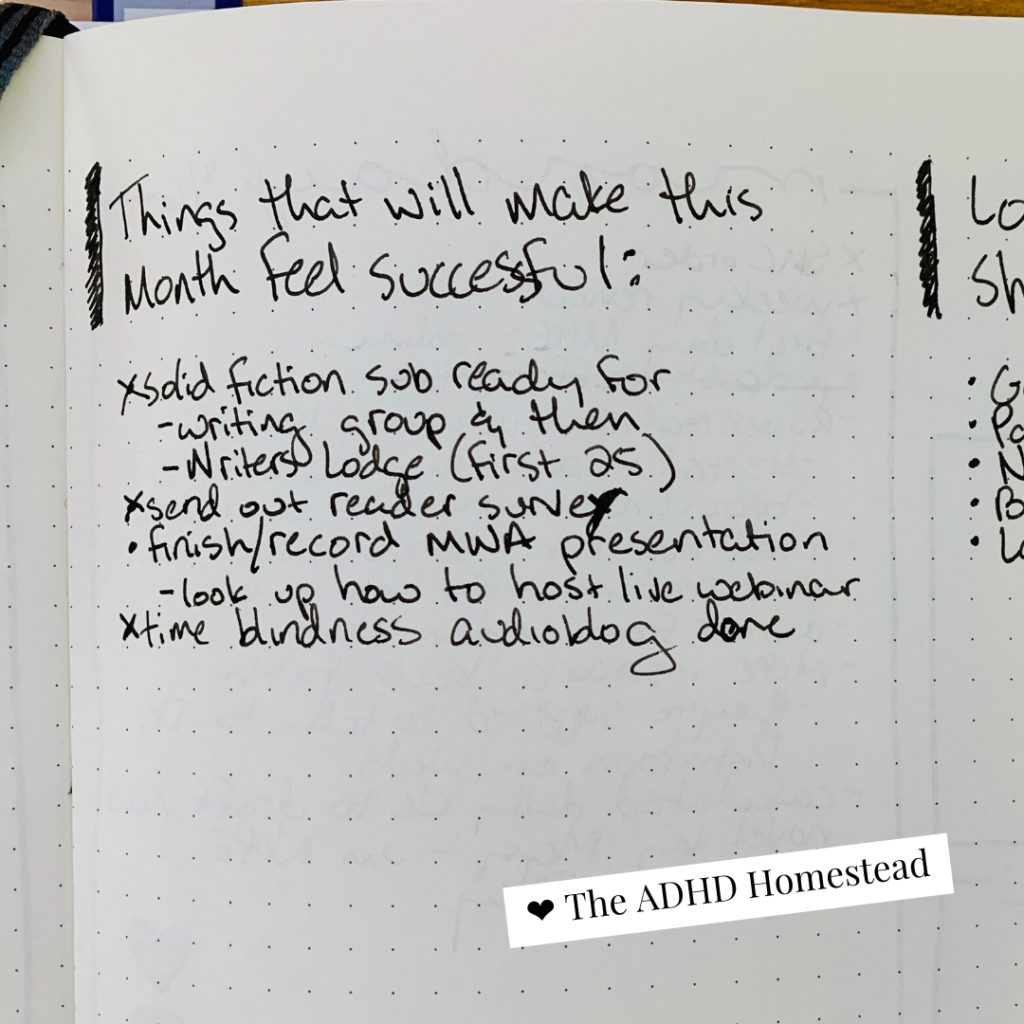Use the player above to listen to the text of this post. To receive expanded versions of new audio posts and other bonus content in your favorite podcast app, become a supporter of The ADHD Homestead on Patreon.
I often compare ADHD’s time blindness to color blindness: a hardwired difference in our perception. However, that implies we can’t do anything about it. The full story has a little more nuance. Despite their impaired color vision, my color-blind friends obey traffic signals and wear matching clothes to work. Likewise, most ADHDers need to live on the real world’s timetable.
I’m always quick to remind people about the emotional implications of time blindness: it’s more than running late or losing track of days. And yet when we struggle to fulfill basic obligations to ourselves and others, that line between the practical and the emotional gets fuzzy. Maybe this explains my obsession with my daily grind. Structuring my life to work with my ADHD helps me feel good about the way I show up for myself and the people I love.
A commenter on a previous post about time blindness responded, “Okay, now what do we do about it?” To answer that, I’m going to share a few strategies I use to make time more concrete and less slippery.

6 ways I keep time from getting away from me
1. Take notes to summarize the day
I sometimes find myself feeling vaguely unsatisfied at the end of the day. I get irritable, restless, and even resentful because I think I haven’t done anything. Most of the time this isn’t true; I’ve just forgotten. To my time-blind afternoon brain, the morning feels like a different day — if it even feels real at all.
I remedy this by taking notes as I go through the day. I’m a Bullet Journaler, but any similar method, including an old-fashioned day planner, would do. The BuJo Daily Log is essentially what our grandparents and great-grandparents would’ve called a dairy.. My own grandfather left behind day planners full of simple, one-sentence reflections — some of them about our time together when he babysat me 30 years ago. Our forebears often took notes on the minutiae of their days, and I think we’re worse off for abandoning the habit.

My Daily Log gives me a more accurate mental picture of what my day was like. It also helps put problems in perspective: did we have that conversation about chores last week, or the week before? Does my husband work late every night, or does it just feel that way? When time blindness tricks us into thinking occasional annoyances happen every day, we might unfairly accuse housemates of “always” behaving badly. Time blindness can also trick us into thinking a problem only popped up recently, or it isn’t that bad, when in reality it’s been driving everyone else crazy for weeks. A written record helps me remember what I did, what I noticed, and how I was feeling on any given day.
2. Bake sourdough bread
This one sounds weird. Hear me out.
I’ve made bread for years, but only recently started experimenting with sourdough. It isn’t time-consuming, but each batch requires attention at regular intervals. Right away, I noticed it felt like a tactile variation on the Pomodoro technique, which breaks productivity into 20-minute work periods.
Sourdough’s natural rhythm of short, low-impact interruptions also reminded me of homework I received from my kid’s therapist. I’m supposed to interrupt his hyperfocus from time to time with something innocuous, like asking him to help me with a very quick chore or answer an easy math problem. This helps him build tolerance to hyperfocus interruptions, practicing briefly coming up for air before settling back in.
When I get up to tend to my sourdough, I notice what I’ve spent the last 30 minutes working on. This noticing makes me feel more empowered to choose what I do next. I also feel more motivated to get straight to what I actually want to do when I return to my desk. Succumbing to distractions like refreshing Twitter or checking my email feels more consequential when I know a timer will disturb me in 30 minutes. Instead of feeling nebulous and abstract, my work time now feels quantifiable and finite.
I don’t always use sourdough this way. Some days it’s laundry. Anything that provides regular, low-impact interruptions helps me stay focused. Ironically, the vanilla Pomodoro method doesn’t work as well. I bail on it too readily. If my brain fights the interruption too hard, I silence the timer. I’m less likely to cheat when my neglect will mess up my bread or mildew my laundry.
3. Review my Bullet Journal Monthly Log at least once weekly
Every Monday, I sit down and review everything I have going on. This includes my Bullet Journal’s Monthly Log. Pre-Bullet Journal, I used apps or day planners to see my month at a glance. This overview reminds me of several things, including what it feels like for a week to go by and how many of this month’s goals I’ve failed to start on yet.
Lately I’ve struggled to prioritize my work. At the beginning of last month, I jotted down a list in my Monthly Log titled “things that will make this month feel successful.” When I look at that list on Monday morning, I remind myself of two things:
- That project I beat myself up for failing to finish this week isn’t even on my list; the month’s work will still feel successful without it.
- If this list will bring me the most fulfillment, I need to find a way to prioritize those items over whatever obsession presents itself today.

Because we’re in a weird time right now — our state is under stay-at-home orders for a pandemic — I’ve also tried to quantify ways I can support my community. I’m currently using my Monthly Log to keep a running list of local restaurants I support each month. It cheers me up when I see it and helps me feel like I’m doing something.
4. Use a smart watch
I love the Apple Watch. Readers have also told me about FitBits and other wearables they use to keep track of time.
To make my watch a tool and not a distraction, I’ve disabled almost all notifications except for calendar reminders (which I curate carefully), timers, and alarms. Timers and alarms, especially, help me more on my watch than anywhere else. I like to keep my distance from my phone during productive times, and I hesitate to use it for reminders because I find notification sounds disruptive. Watch notifications nudge me with a discreet vibration on my wrist. I can use it to set reminders for anything that feels helpful, without worrying about bothering others or needing my phone nearby.
While I don’t rely on alarms as much as some, I have benefited from a recurring “Get ready for bed!” alarm every night at 10:15. This is the kind of thing that would feel silly on my phone where everyone else can see and hear, but makes perfect sense on my watch.
5. Keep my schedule in front of me
Many ADHDers I know won’t remember to look at a clock or a to-do list throughout the day. We forget time exists at all — why would we remember the clock? Forcing timekeeping devices and reminders under my nose helps combat this.
I’ve embraced the Apple Watch’s face complications to remind me of upcoming obligations. I chose a watch face that shows my next calendar event prominently in the middle. Every time I check the time, I see the next thing I have coming up.

On the analog end of things, my Bullet Journal keeps my schedule in front of me from the time I wake up to the time I go to bed. At night, after I review my Daily Log one last time, I leave it open at my place at the breakfast table. This is usually when I realize I haven’t yet taken out the trash. Then it greets me first thing in the morning with a reminder of what my day will look like. I carry it to my desk and leave this spread open while I work.
This sounds like a lot, but I lose my grip on the day pretty easily without a visual reminder.
6. Budget and track time with manipulatives
Last summer my work schedule and routine changed dramatically. I had trouble learning to budget my time in a new reality (sound familiar?). As with many things, the solution was to externalize it instead of trying to wrangle an abstract concept in my head.
To get a handle on the problem, I used buttons — the first collection of small objects I could lay hands on — to represent half-hour increments of time. Then I laid out a grid on a piece of paper and labeled each section with a different work category: writing code, checking email, blogging, etc. I placed buttons on the grid to either plan how much time to spend on each project or track how I spent my time throughout the day.
This system helped immensely. Suddenly the answer to the question, “where did my time go?” was no longer opaque. My buttons also helped me manage disruptions to my routine. After a morning meeting that would normally have thrown my productivity off for the rest of the day, I counted out my remaining buttons and realized I had more available work time than I thought.
We don’t need fancy solutions, we just need something that works
While I have high praise for the Apple Watch, you’ll notice most of these tools aren’t fancy. They’re cheap, simple, and effective.
It’s easy to get hung up on the process. We want to find or build the perfect tool, so we hyperfocus on that instead of the task the tool is supposed to help us complete. Or we refuse to do the task because we lack the perfect tool. We think if only we could afford to buy this thing, or if only we had time to create a better system, then we could succeed. For now we’re stuck.
It doesn’t have to be that way. Don’t wait for perfection when you’re lost in the weeds with time blindness. Jump in with the best solution you can hack together today. That’s what I did with my buttons: one morning I’d had enough. Blinded by my frustration, I grabbed the nearest set of 16 small objects and a piece of blank paper. The key is to find ways to make time feel external, concrete, and tangible. Anything that accomplishes that, no matter how cheap or silly, will leave you better off than where you started.
How about you? Have you developed any techniques for working with your time blindness?
Hey there! Are you enjoying The ADHD Homestead?
Here's the thing: I don't like ads. I don't want to sell your attention to an advertising service run by the world's biggest data mining company. I also value my integrity and my readers' trust above all, which means I accept very few sponsorships/partnerships.
So I'm asking for your support directly. For the cost of one cup of coffee, you can help keep this site unbiased and ad-free.
Below you will find two buttons. The first lets you join our crew of Patreon pals and pledge monthly support for my work. Patrons also have access to my Audioblogs podcast. The second takes you to a simple donation page to pledge one-time or recurring support for The ADHD Homestead, no frills, no strings. Do whichever feels best for you!
